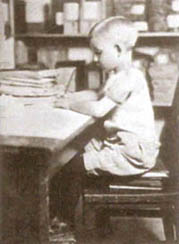 |
Formation of Children
The Proper Way to Sit, Walk, and Stand
Marian T. Horvat
A straightforward gaze and respectful attitude is important for good deportment. But it is also necessary to know how to sit, walk and stand properly. Chapter 3 of the Small Manual of Civility presents basic postures that should be expected from a young man of good education.
Standing
Correct bearing should be natural and unaffected, without a pedantic, haughty or pretentious air.
Standing, one should not rest all the weight of the body on one leg, leaving the other slack or hanging. It is not proper to lean on a tree, wall, or piece of furniture. It would be even worse to bend one leg and place the sole of the shoe against the wall, or rest a knee on a bench or chair.
The head should be inclined slightly forward, without moving it from one side to another, or forward and backward.
The feet should be together, at a slightly open angle, and the knees almost together. One of the arms should hang naturally, while the other is slightly bent next to the body. Avoid tracing designs or any kind of geometric figures or lines on the ground with the tip of your foot or a cane.
During a conversation, do not tip backward or forward on your feet, like a pendulum.

Prince Albert of Monaco, the correct way to walk |
Walking
When walking, avoid precipitation when it is not necessary to rush. The step should be firm, without exaggeration. Sluggishness in walking is a sign of a weak, sickly, or lazy temperament.
The arms should move slightly following the rhythm of the step, each foot being placed firmly and solidly in turn on the ground, without making a loud thumping sound.
While walking one should not twist the head or torso to one side or the other; this reveals a lack of basic education regarding deportment. Do not look behind you while walking, nor make abrupt turns of the head or body.
Sitting
When the moment to sit arrives, choose a humble place. If an armchair is offered to you, refuse it courteously. If one insists that you take it, you should accept and sit in it properly, avoiding an attitude of softness or laziness.
It is not proper to fall into the chair, nor to rise from it abruptly. Once seated, do not lean the body forward or slump into the back of the chair.

Above, a wrong way to sit.
Below, sitting with good posture
 |
The feet should set perpendicular to the ground, the knees almost together. It would be uncivil to stretch out the legs, or place one foot on top of the other. If you are in special company, do not cross your legs. Among friends of the same level, it is normal to do so.
It is yet more unpardonable to put your hands under your legs or on your shoes, hold one knee with your hands crossed in front of it, etc.
Once seated, take care to not fidget or stir anxiously on the edge of the seat. Your arms should not be extended over the arms of the chair or bench; also, do not place them over or behind the seat back of the neighboring chair.
When standing or seated, do not hold your cane or umbrella in your hand; these objects should be placed in an appropriate place.
In the presence of another person, avoid passing your hand through the hair, putting your fingers in your ears or nose, scratching your face or any part of the body, placing your hand in the opening of your shirt or trouser pockets. These habits are reprehensible.
Remember the maxim: A fool does not sit, rise, listen, or walk, like an intelligent man.
Good manners count
Also, consider this example: Colbert was the son of a cloth merchant who rose to be the Minister of Finance of the King of France, Louis XIV. Because he was from a humble family, he was obliged to achieve that high dignity by means of work and merit. Here you will see how good manners served him at the beginning of his brilliant career.
Already at that time, places in profitable businesses were very coveted and often attained by a word from persons of influence or many letters of recommendation. Colbert was twelve-years-old when he had occasion to apply for a promising place in a commercial business. But there was only one vacancy to be filled and many applicants. Almost all brought letters of recommendation, and Colbert had none.
To determine the most suitable candidate, the director of the business decided to make some tests: First, he invited all the applicants to appear in his office at a certain time. When he opened the door, the boldest youths pushed forward into the room and chose the best seats. Young Colbert, like several others, remained standing, hat in hand, waiting outside until someone indicated he should enter and showed him a place to sit.
The director had purposely left open the door of an adjoining room, where there were some papers on the floor. No one except Colbert rose from his chair in order to pick them up and give them to one of the employees of the firm.
The director then left the office for some minutes. Only Colbert had the courtesy to rise as a sign of respect when he returned.
After these tests, the director hesitated no longer and chose young Colbert to fill the one existing vacancy.
At first glance, one might think these instructions either so obvious they hardly need saying or too fastidious for modern times. I don’t agree with either argument.
First, these rules are not at all obvious. Look around us today, and we rarely find a young man following these basic rules on how to stand, sit, and walk. We are living in the age where the relaxed and spontaneous way of acting dominates everywhere. Many youth have never learned there is a correct way to stand, sit and walk; on the contrary they were taught to simply do what they feel like. So it is common to see boys slouching in chairs, crawling over furniture – even in public, leaning on walls, and so on.
But neither ignorance of civility nor laziness is an excuse to become barbarian.
Second, these rules are hardly fastidious. Rather, they are meant to make life more interesting, dignified, and appropriate for Catholics who take the principles of the Gospel seriously. They stimulate a man to self-control, and to exercise a constant vigilance over his actions.
When a group of well raised people gather together, they enjoy themselves very much. Having learned to control their lower instincts, they are naturally open to subjects of a higher level in their conversations. The rules of civility make the practice of a life of virtue easier, and help to build a Catholic civilization.

Posted September 7, 2006

Related Topics of Interest
 Bearing Bearing
 Dressing Well - Vanity or Virtue? Dressing Well - Vanity or Virtue?
 St. Isidore of Seville on the Importance of Being Dignified in Manner St. Isidore of Seville on the Importance of Being Dignified in Manner
 Four Ways to Discern a Man's Soul by His Appearance Four Ways to Discern a Man's Soul by His Appearance
 Why Do Only Women Have to Dress Well? Why Do Only Women Have to Dress Well?
 Tradition, Stagnation and Progress Tradition, Stagnation and Progress
 Courtesy in the Catholic Home Courtesy in the Catholic Home
 Language is the Dress of Thought Language is the Dress of Thought
 Questions on Fashion Questions on Fashion
 R-CR in the Tendencies, Ideas and Facts R-CR in the Tendencies, Ideas and Facts

Related Works of Interest
|
|
Formation | Cultural |
Home | Books | CDs
| Search | Contact Us
| Donate

© 2002- Tradition in Action, Inc. All Rights Reserved
|
 |
|